Gallery post.
Autumn walking along the River Wissey
05 Wednesday Oct 2016
Posted in Uncategorized
05 Wednesday Oct 2016
Posted in Uncategorized
Gallery post.
02 Saturday Jan 2016
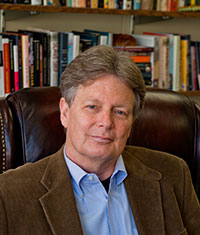
Professor Marcus Rediker
Professor Marcus Rediker will deliver an illustrated lecture on Benjamin Lay (1682-1759), who worshiped at the Quaker Meeting House in Abington. Lay was zealous abolitionist in a time when Quakers still owned slaves, a radical who was repeatedly disowned by Quakers for his views on slavery and “false ministers.” He opposed the death penalty, and refused to use any item made with slave labor. Professor Rediker’s lecture will offer a reassessment [and discussion?] of Lay’s place in history.
The lecture will be held on Tuesday, February 2, 2016 at 7:00 p.m., in the John Barnes Room of Abington Monthly Meeting House, The event is expected to be well-attended; we suggest you arrive early for best seating. For more information, contact meeting secretary Loretta Fox at amm@abingtonfriends.net.
Marcus Rediker is Distinguished Professor of Atlantic History at the University of Pittsburgh. He is author of nine books, his most recent being Outlaws of the Atlantic: Sailors, Pirates, and Motley Crews in the Age of Sail (Beacon Press, 2014). He also produced Ghosts of Amistad: In the Footsteps of the Rebels, a film documentary about how the Amistad slave ship rebellion of 1839 is remembered in contemporary Sierra Leone.
For further information on the radical life of Benjamin Lay visit: Quakers in the World
31 Thursday Dec 2015
William Penn adopted, at best, a paternalistic attitude towards black slaves ‘looking upon a slave not as the property of the master but as a member of the family’.
The immediate American association with William Penn and the Americas in many people’s mind is the State of Pennsylvania, but he was also involved in the bloody English annexation and the settlement by Quakers of the New York and New Jersey areas. These lands were already settled by slave-owning Europeans, a system of enforced labour which continued and was expanded during English rule.
As referred to in previous posts Penn was a close friend of the Duke of York (later James II). In 1664, the Duke was given the area of New Amsterdam (renamed New York in his honour) and beyond.
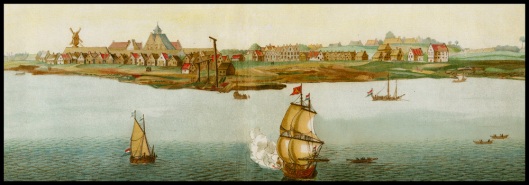
New Amsterdam (NYC Dept of Records)
Quakers were already established in the colony at Flushing and Oyster Bay. Previously, under the Dutch West India Company, the slaves of New Amsterdam had lived in what was known as ‘half-freedom’, that is to say they had some rights and some, limited, independence. However, once under British rule they became chattel slaves, i.e. perceived as personal property of the slave owners in a way that was different from previous slave-systems. It was slavery used as labour under an emerging and consolidating capitalism. Although it is worth noting that these urban slaves never accepted the complete servitude endured by their rural counterparts. None of this ever seemed to affect Quaker William Penn’s friendship with the Duke. By 1687 Quakers were extremely populous in the slave-based colony of New York. As Governor Dongon reported:
‘Here bee not many of the Church of England, (and) few Roman catholicks, [but] abundance of Quakers – preachers men and women, especially – singing Quakers, ranting Quakers, Sabbartarians, Anti sabbatarians, some Anabaptists, some Independents, some Jews; in short, all sorts of opinions there are some, and the most part none at all.’
The Quakers of Pennsylvania used euphemisms for their slaves referring to them as ‘servants’ and their labour as ‘service’. This makes it difficult to ascertain how many slaves the Penn family owned in Pennsylvania. In 1685, he wrote casually of his ownership of slaves of the use of slave labour for the transportation of goods through the colonies:
“ Let him have one of the blacks of Allen, two of which are as good as bought, such a one as is most used to sea…. “
Slave ownership was written into the first Frame of Government of the Province of Pennsylvania. Penn’s Quaker professions of equality and fair play counted for little or nothing once confronted with a rapidly growing province with an acute shortage of labour to work the lands and carry out the multitude of tasks demanded by rural and urban Quaker society. Wage labour at this time was difficult to obtain in a Pennsylvania where land was cheap and fertile and where credit was readily available. Quaker pragmatism therefore, demanded the labour of slaves.
Quakers dealt directly in trading slaves. James Claypool a Quaker and member of the Free Society of Traders had a joint business with other Quakers to buy slaves from his brother in Barbados. Penn’s agent, Philip Lehnmain, used a ship, The Isabella’, to trade for slaves. In 1683 Penn himself was actively dealing in slaves, buying a number from Captain Nathaniel Allen. Penn was also selling slaves. He sold one who was an excellent fisherman for ‘a full price, for the man will expect it of me‘.
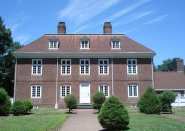
Pennsbury Manor (reconstructed), Falls Township, Pennsylvania
Exactly how many slaves worked at the Pennsbury Mansion and Plantation (left) belonging to William Penn is not clear. They were numerous: two slaves, Yaffe and Chevalier, were mentioned as Penn’s favourite “servants” and a slave named Tish was the personal servant of Penn’s daughter, Letitia. Certainly, by 1687 Penn had decided that his plantation at Pennsbury should use only slave labour with a white overseer. In a letter from England to his agent in Philadelphia on this preference for slave labour over white indentured labour:
“It was better they was blacks for then a man has them while they live.”
Pennsbury was Penn’s country estate and mansion in Pennsylvania. It was referred to as his “palace”. As an aristocrat, Penn obviously thought that a slave plantation was the natural inheritance for his children when wrote of Pennsbury:
“Let my children be husbandmen and housewives. This leads to consider the works of God and nature and diverts the mind from being taken up with the vain arts and inventions of a luxurious world. Of cities and towns of concourse beware. The world is apt to stick close to those who have lived and got wealth there. A country life and estate I like best for my children”.
To a certain degree, Penn recognised that slavery was unjust. At one point, he proposed that slaves in Pennsylvania be freed after a certain period of bondage. He suggested the creation of a township, called Freetown, where freed slaves could live, but the hard-nosed Pennsylvania Assembly [nearly all Quakers] rejected the idea.
Penn’s will of 1701 included this clause:
“…& my blacks (given) their freedom, as under my hand already….”
This is the only one of William Penn’s wills that contains such a clause. Neither his will of 1705 nor his last will of 1712 repeated this, and, while Penn is said to have freed some slaves during his lifetime, other slaves passed to his heirs at his death.
What is known, as stated earlier, is that a “servant”, Virgil, was sold in 1733 to Thomas Penn by Joseph Warder providing evidence that the colonial Penn family never given up the ownership of slaves.
29 Wednesday Jul 2015
Posted in Colonial History of the USA, Women's History
It’s not often one sees depictions of everyday 17th Century women going about their daily work, but the images on Barbara Wells Sarudy’s blog shows a series of women street sellers from the library of the diarist Samuel Pepys (1633-1703).
Here’s one example, just to whet your appetite:
29 Wednesday Jul 2015
Tags
American Colonial History, Benjamin Franklin, Christiana, Christopher Sauer, indentured servants, Iron Masters, Peter DeHaven, Quaker History, Slavery, The Pennsylvania Gazette
As well as directly using slave labour, the American colonies, including Pennsylvania, were economically dependent on trade with the slave economies of the West Indies. West Indian plantation owners saw the growing of food as being less profitable than producing sugar and its by-products so they imported their foodstuffs from the English colonists on the American mainland thus underpinning and sustaining the slave labour economy.
In Pennsylvania the seasonal demands of cereal farming meant that its agriculture was not particularly viable for the employment of large numbers of slaves. Generally, farmers in Pennsylvania preferred to use indentured servants rather than slave labour. In the Chester and Lancashire Counties of Pennsylvania two thirds of the bond ‘servants’ held by the wealthiest Pennsylvanian farmers were indentured servants rather than slaves. Slaves were often seen as status symbols by white masters – working in the fields at planting and harvest times and working as domestic servants in their master’s or mistress’s house at other times.
Most slaves in North American colonies were in rural work but others were in industries like tanning, salt, mining and iron manufactory concerns. The Iron Masters were the largest employers of industrial black slaves. In fact the Pennsylvanian Iron Masters’ reliance of slave labour was so high that at one time they petitioned for a reduction in the tariff on the importation of slaves in order that they could keep their furnaces in operation.
During the middle of the 18th Century there was a change of policy in the purchase of slaves into the Northern colonies. This was brought about by the difficulty of obtaining white indentured labour. Merchants began to import slaves directly from Africa. Before 1741, 70% of slaves arrived in the Northern colonies from the West Indies and other American mainland areas, after 1741, however, 70% of slaves came direct from Africa. Slaves were used not only in the traditional rural ‘provisions’ trade but increasingly in cities. By the 1760s black slaves constituted two thirds of the servant population of Philadelphia. In wills and inventories of the time chattel slaves were often listed amongst other valuable items of household property such as clocks and carriages. Here is an extract from the Will of the yeoman, Peter DeHaven of Philadelphia, dated 1767:
“….Secondly I give unto my well beloved wife Elizabeth one third of my whole Estate to be paid to her by my Executor within twelve Months after my Decease. I also give unto her my malattow [mulatto] child now living with me….”
Amongst the wealthy and middle classes in the towns and cities of the American colonies the ownership of slaves was practically universal. It was only the lack of living quarters which prevented many of them from increasing the number of slaves in their households. This lack of living accommodation in urban areas also meant that female slaves were frequently sold as soon as they were discovered to be pregnant. One of the effects of this policy, as well as the distress caused to the women concerned, was that there was a move towards female slaves with children ‘living out’ thus they acquired some measure of independence and freedom from direct control by their ‘masters’ over every aspect of their lives.
As a result of the Gradual Emancipation Act of 1780, the 3,737 African American slave population of 1790 Pennsylvania had dropped to 64 by 1840. By 1850 all Pennsylvanian African Americans were free unless they were fugitives from the South. In Pennsylvania on September 11th, 1851 it was reported that ‘….a group of blacks dispersed slave catchers in Christiana [Pennsylvania]. One White man was killed, another wounded.’
Benjamin Franklin’s newspaper, The Pennsylvania Gazette, contained countless paid advertisements for the sale of slaves, as well as notices about runaway slaves. Very often, an advertisement of a hardworking black “servant” ended with the words “Enquire of the printer hereof” . In other words, Franklin himself would handle the sale and take a commission. For example:
“To Be Sold. A likely young Negro woman, can wash or iron or do any kind of household work, as is fit for either town or country; with two children. Inquire of George Harding Skinner, or the Printer hereof.”
Another of Franklin’s advertisements showed how the splitting up of families was seen through the lens of profit & loss:
“[A female slave would be sold with her 2-year-old son, but] another boy aged about six years who is the son of the above said woman will be sold with his mother or by himself, as the buyer pleases.”
But not all colonial newspapers carried such advertisements. Philadelphia’s German-language paper, published by Christopher Sauer, refused to run ads for slaves.
It was only late in Benjamin Franklin’s life that he became an abolitionist. After the ratification of the Constitution, Franklin joined Quakers and other liberals in petitioning Congress to abolish slavery. Their petition faced strong opposition and went nowhere.
15 Monday Apr 2013
Posted in Colonial History of Pennsylvania
Tags
African-American History Pennsylvania, American Colonial History, History of USA, Pennsylvania History, Quaker, Quaker History, silhouette portraits, Visual Arts
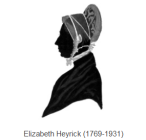 Just follow the link from Quaker Strongrooms below for a good description of the history of silhouette portrait making in Colonial America with particular reference to Quakers. Also has details of how to make your own silhouette portraits!
Just follow the link from Quaker Strongrooms below for a good description of the history of silhouette portrait making in Colonial America with particular reference to Quakers. Also has details of how to make your own silhouette portraits!
Playing with shadows: silhouette portraits and how to make them.
03 Wednesday Apr 2013
Tags
abolition, African-American History Pennsylvania, Friends House London, Geoffrey Plank, History of USA, John Woolman, New Jersey, Pennsylvania, Pennsylvania History, Perth Amboy, Perth Amboy New Jersey, Quaker, Quaker History, Religion and Spirituality, Slavery, William Penn
A talk, “John Woolman and the Utility of History” will be given by Geoffrey Plank on Tuesday 30 April 2013, 6-8pm, Quaker Library, Friends House, 173 Euston Rd, London NW1 2BJ
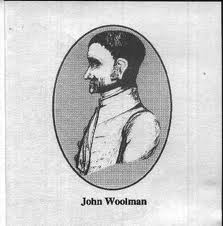 John Woolman has been described as a “Quaker saint,” an isolated mystic, singular even among a singular people. But as historian Geoffrey Plank recounts, this tailor, hog producer, shopkeeper, schoolteacher, and prominent Quaker minister was very much enmeshed in his local community in colonial New Jersey and was alert as well to events throughout the British Empire. Responding to the situation as he saw it, Woolman developed a comprehensive critique of his fellow Quakers and of the imperial economy, became one of his era’s most emphatic opponents of slaveholding, and helped develop a new form of protest by striving never to spend money in ways that might encourage slavery. Drawing on the diaries of contemporaries, personal correspondence, the minutes of Quaker meetings, business and probate records, pamphlets, and other sources, John Woolman’s Path to the Peaceable Kingdom shows that Woolman and his neighbours were far more engaged with the problems of inequality, trade, and warfare than anyone would know just from reading the Quaker’s own writings. Although he is famous as an abolitionist, the end of slavery was only part of Woolman’s project. Refusing to believe that the pursuit of self-interest could safely guide economic life, Woolman aimed for a miraculous global transformation: a universal disavowal of greed.
John Woolman has been described as a “Quaker saint,” an isolated mystic, singular even among a singular people. But as historian Geoffrey Plank recounts, this tailor, hog producer, shopkeeper, schoolteacher, and prominent Quaker minister was very much enmeshed in his local community in colonial New Jersey and was alert as well to events throughout the British Empire. Responding to the situation as he saw it, Woolman developed a comprehensive critique of his fellow Quakers and of the imperial economy, became one of his era’s most emphatic opponents of slaveholding, and helped develop a new form of protest by striving never to spend money in ways that might encourage slavery. Drawing on the diaries of contemporaries, personal correspondence, the minutes of Quaker meetings, business and probate records, pamphlets, and other sources, John Woolman’s Path to the Peaceable Kingdom shows that Woolman and his neighbours were far more engaged with the problems of inequality, trade, and warfare than anyone would know just from reading the Quaker’s own writings. Although he is famous as an abolitionist, the end of slavery was only part of Woolman’s project. Refusing to believe that the pursuit of self-interest could safely guide economic life, Woolman aimed for a miraculous global transformation: a universal disavowal of greed.
Geoffrey Plank will discuss the “moral utility” of studying history, with the abolitionist John Woolman (1720-1772) continuously at the centre of the analysis. Plank will look at Woolman from two angles, examining how Woolman thought about history and invoked it in his effort to instigate reform, and also considering how Woolman became history and the uses that have been made of his life story to inspire subsequent generations.
Register for a free place at www.quaker.org.uk/quakerhistory
For all enquiries please contact the Quaker Library library@quaker.org.uk / or 020 7663 1135
Here’s an extract concerning John Woolman from my recent booklet on William Penn:
“John Woolman (1720-1772) was a Quaker campaigner who spoke out against slavery in the Northern States. In his time, the number of slaves in New Jersey was high, as late as 1800 they numbered 12,422. In Perth Amboy, New Jersey, newly imported Africans arrived and a long barracks was built to accommodate them. In 1734, when Woolman was fourteen, an insurrection of slaves took place at Perth Amboy. The slaves, in an alliance with Native Americans and the French, attempted to kill their British owners. Some years later a slave convicted of crime was burned alive at Perth Amboy and a huge number of slaves from all the neighbouring townships were made to witnesses his slow and painful death. It was these and other events, made Woolman speak out. In his Journal he records the process of deciding to actively campaign amongst his fellow Quakers against slavery. “My employer, having a negro woman, sold her, and desired me to write a bill of sale….I felt uneasy at the thoughts of writing an instrument of slavery for one of my fellow-creatures, yet I remembered that it was my master who directed me to do it, and that it was an elderly man, a member of our Society [i.e. a Quaker], who bought her…. Sometime after this a young man of our Society spoke to me to write a conveyance of a slave to him, he having lately taken a negro into his house…. I spoke to him in goodwill; and he told me that keeping slaves was not altogether agreeable to his mind; but that the slave being a gift made to his wife, he had accepted her.” In 1746 Woolman set out on a 1,500 mile round-trip preaching on a number of topics including slavery. He visited fellow Quakers who owned slaves in Pennsylvania and attending Quaker meetings to speak out against human trafficking. In 1761 he wrote: “…. In this visit I was at two Quarterly and three Monthly Meetings, and in the love of truth I felt my way open to labour with some noted Friends who kept negroes.” In 1762 he wrote and had printed, “Considerations on keeping Negroes“. His distributed it to fellow Quakers in Pennsylvania and elsewhere and also, importantly, to slaves themselves: “….members of our religious society in general, among whom are some who keep negroes, and, being inclined to continue them in slavery, are not likely to be satisfied with such books being spread among a people, especially at their own expense, many of whose slaves are taught to read, and such, receiving them as a gift, often conceal them.”26 Tuesday Mar 2013
Tags
Admiral Sir William Penn (1621-1630), Bristol, English Revolution, James Allen, Prince Rupert, Quaker History, Reverend Thomas Clarkson, seven stars tavern, St Mary Redcliffe, St Thomas Church Bristol, Thomas Becket, William Venn Gough
We know that Admiral Sir William Penn (1621-1670), (William Penn the Quaker’s father) was born in St Thomas’ Parish, Bristol but his date of birth is not recorded. It is known that he was baptised in St Thomas church on 23rd April, 1621. St Thomas church is close to the River Avon in Bristol and the district was the centre of much of the city’s maritime and industrial activity at that time. During the English Revolution (1640-49) Admiral Penn, when not at sea, lived with his family in London. in 1643 his home city of Bristol was attacked by Royalist forces led by that most brutal of commanders, Prince Rupert (the German nephew of Charles I). Rupert’s forces robbed, sacked and burned homes, turning out many from their houses.
St Thomas Martyr parish was part of a suburb which was probably laid out in the 12th century. The church (also known as St. Thomas the Apostle), in St. Thomas Street was described as ‘an elegant building’ as early as 1200. The parish was full of rich clothiers who donated money to the church. Before the completion of St Mary Redcliffe, members of the influential Canyngyes family were buried in St Thomas.
The church was dedicated to Thomas Becket, who was martyred at Canterbury, Kent in 1170 and canonised in 1173. In 1538 Henry VIII ordered that Becket should no longer be considered a saint and references to “the martyr” were crossed out of the church records. Under the Tudor Reformation the St Thomas Parish became part of the Diocese of Bristol when that diocese was created in 1542.
In 1789 the church, except for its famous 14th century leaning tower, was demolished and the present church was built. The nave was rebuilt 1791–93 by James Allen.
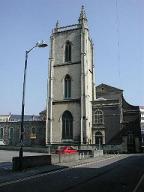 St Thomas was granted independent parochial status on 16 October 1852.
St Thomas was granted independent parochial status on 16 October 1852.
Between 1878 and 1880 significant changes were carried out by William Venn Gough. Later, 1896-97, Gough remodelled the top of the tower with a spirelet, pinnacles, and pierced parapet.
St Thomas church survived the blitz of World War Two but the area around changed beyond recognition. Most of the surrounding area became covered by office blocks.
When the Reverend Marwood Paterson retired in the 1940s, no new vicar was appointed. The church, devoid of a local population, struggled on for several years. The parish was united with St Mary Redliffe in 1956 and the church was used as a centre for the propagation of Christianity among those engaged in industry in Bristol. This work was transferred to the Bristol Cathedral in 1977. The last service was held at Christmas 1982. It is now closed and in the care of the Churches Conservation Trust.
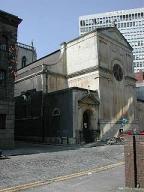 Little now survives of the old parish buildings, once home to rich clothiers, glovers, glassmakers and wine importers whose trading activities supported the church.
Little now survives of the old parish buildings, once home to rich clothiers, glovers, glassmakers and wine importers whose trading activities supported the church.
One of the few remaining inns of the parish is the Seven Stars Tavern, right next to St Thomas’, where anti-slavery campaigner, Reverend Thomas Clarkson, gathered information on the slave trade. His evidence helped bring about the abolition of slavery in Britain and is commemorated by a community plaque by Mike Baker.
26 Tuesday Mar 2013
Tags
Admiral Sir William Penn (1621-1630), African-American History Pennsylvania, American Colonial History, Bristol, Gulieima Springett (1644-1694), Hannah Callowhill (1671-1726), History of USA, M-Shed, Pennsylvania History, Quaker History, Transatlantic Slave Trade, UWE Regional History Centre, William Penn (1644-1718)
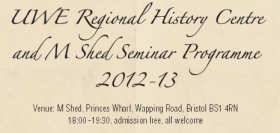 Last Thursday, as part of the Winter series of lectures organised by the Regional History, I delivered an illustrated talk on “The Quaker, William Penn ~ an alternative view of the founder of Pennsylvania”.
Last Thursday, as part of the Winter series of lectures organised by the Regional History, I delivered an illustrated talk on “The Quaker, William Penn ~ an alternative view of the founder of Pennsylvania”.
Despite the cold and rain there was a good turnout of 45-50 people (including local Quakers and staff from the American Museum, Claverton Manor, Bath) to hear my talk on role of William Penn and his family in the colonisation of Ireland, Transatlantic Slave Trade and European expansionism in the North Americas.
There was great discussion both during and after the talk about differing (and, I think, changed) perceptions of the historical role of Quakerism.
My thanks to the UWE Regional History Centre and the M-Shed for their help and support.
If you would like me to give a talk to your organisation then just get in touch with me and I’ll be happy to try to oblige.
25 Monday Mar 2013
Posted in Quaker History
Tags
Quaker, Quaker History, Religion and Spirituality, Religious Society of Friends, The Street Corner
The Street Corner website is well worth a visit. It explores the common history of groups such as quakers, diggers, rainbow family, christians, taoists, civil libertarians, democrats, republicans, and other divers radicals.
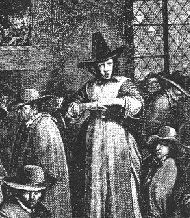 Click here for an index of Quaker-specific historical materials available, within The Street Corner site and elsewhere on the web.
Click here for an index of Quaker-specific historical materials available, within The Street Corner site and elsewhere on the web.